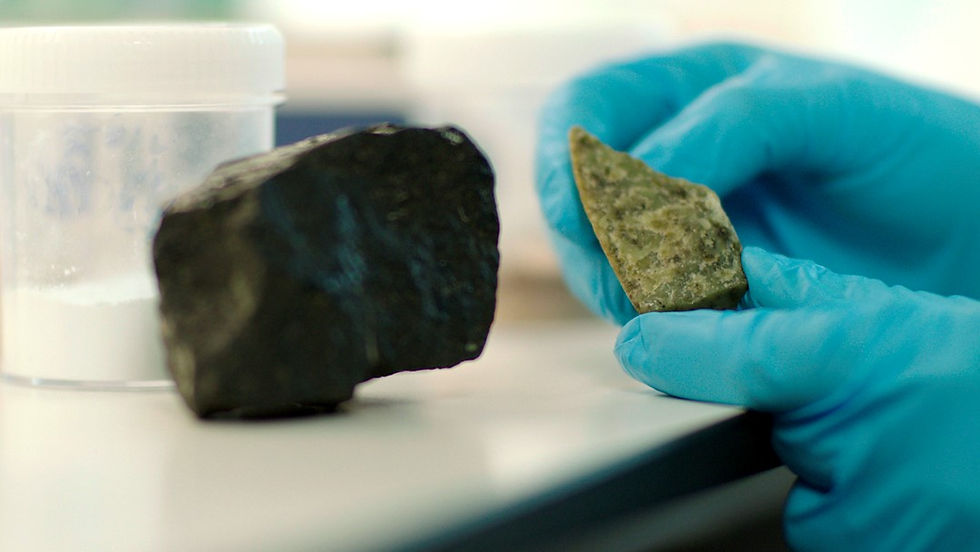The hidden backbone of 21st century industry: why critical minerals magnesium and NMC hydroxides matter and why current supply chains are a risk
- Anna Reid

- Jul 29
- 6 min read
Updated: Jul 30
As the world looks ahead to an electrified, cleaner 21st century industrial sector, the spotlight often falls on lithium and rare earth elements.

But behind the scenes, magnesium hydroxide and nickel-manganese-cobalt hydroxide (NMC) are doing some heavy lifting—quietly enabling everything from high-performance batteries to advanced manufacturing materials and industrial decarbonization.
Access to these materials is critical for national resilience and security, yet the way we source and process them today is riddled with economic, environmental, and geopolitical risks.
Why these critical minerals matter
Magnesium, nickel, manganese and cobalt are on every leading economy’s critical mineral strategy hit list, identified for their strategic application in the defense, infrastructure, energy and manufacturing sectors. Here’s broadly how they are used today.
Magnesium hydroxide: The unsung hero of the industrial sector
A versatile compound, magnesium hydroxide is used for:
Industrial processes. The slow-release alkaline mineral is used for flue gas treatment to neutralize acidic emissions, and as an input to wastewater treatment to neutralise acidic wastewater, remove heavy metals, reduce odours, break down solids and limit corrosion of pipework infrastructure. It’s also used as a flame retardant due to its ability to absorb heat and dilute flammable gases.

Alloying. The demand for magnesium metal is growing, especially for alloying with aluminium, which produces a lightweight yet durable metal, ideal for automotive, robotics and consumer electronics manufacturing. The favourable weight-to-strength ratio means magnesium metal is also being used in aerospace and defence equipment—the key reason why magnesium is on the strategic critical minerals list of all leading economies. The use of magnesium hydroxide in the production of magnesium metal is increasing because the chemical form makes it easier to manage purity, it’s stable and is safe to handle.
Carbon capture and mineralization. Lesser known but hugely effective is magnesium hydroxide’s ability to mineralise point source CO2 emissions. Where hard-to-abate industries struggle to limit their onsite emissions, magnesium hydroxide can transform CO2 into a durable, stable magnesium carbonate material.
Controlled release alkalinity, high purity, thermal stability and CO2 reactivity characteristics make magnesium hydroxide a superior mineral for industrial processes, alloying and carbon capture.
Nickel-manganese-cobalt (NMC) hydroxide: The heart of high-performance batteries
Nickel-manganese-cobalt hydroxide is a precursor for NMC cathodes, found today in:
Electric vehicles (EVs). NMC is the most-used cathode material in today’s EV batteries. When used in lithium-ion batteries, NMC stores and releases lithium ions during charge and discharge cycles. This is important as NMC balances the key things people look for in an EV: range, power and lifespan.
Grid-scale energy storage. As renewable energy infrastructure scales so too does the need for grid-scale energy storage solutions. With efficient energy storage, renewables will be more effective at displacing fossil fuel energy. As in EV batteries, NMC cathodes provide high energy density and long cycle life needed to support grid-scale energy storage.

With renewable energy comes the challenge to store sunlight and wind energy across the grid, so we can use that energy when we need it, anytime. NMC-cathodes provide the high density and long cycle life these huge energy storage systems require. Photo: Vinnie Van Wyk, ArtGrid
Advanced defence systems. The high-density characteristic of NMC batteries makes them an ideal power source for robotics and modern unmanned defence systems such as drones and other autonomous long-range vehicles.
Electronics. Smaller and lighter is the objective for today’s consumer electronics, and NMC cathodes enable compact energy solutions for the portable devices we (now) can’t live without: smartphones, power tools and laptops.
The energy density, thermal stability, and longevity NMC cathodes offer make them a cornerstone of the energy transition.
The supply risks with these critical minerals: Fragile, geopolitically exposed and unsustainable
Despite their importance, the supply chains for these hydroxides are highly vulnerable:
Magnesium production is dominated by China, which controls over 88% of global supply and has previously restricted exports, creating supply shortage mayhem across the world.
Nickel and cobalt are largely mined in Indonesia and the Democratic Republic of Congo, respectively—regions that have known environmental and governance challenges. Over 80% of refining is controlled by China too, which links in with trade import tariffs and export restrictions that can weigh heavily on end users’ confidence.
Manganese is predominantly mined in South Africa and Gabon, but to process it into high-purity battery grade manganese sulphate, it needs to travel to China, who dominates with 90% of global production.
Production processes of these critical minerals are energy-intensive and often powered by fossil fuels, undermining the very climate benefits that the end use applications are meant to support. Plus, current refining methods don’t result in high purity outputs, either introducing unwanted contaminants or failing to remove impurities.

These vulnerabilities translate into real-world risks that impact businesses and nations:
Economic risks: Price volatility and supply disruptions impact the industries that use these minerals – stalling industrial productivity, delaying high-tech deployment and driving up costs for end consumers. Poor quality, low purity minerals equate to unexpected costs too, as end users need to mitigate performance risks with additional testing or purification processes.
Security risks: An overreliance on a few nations for critical inputs weakens national security, particularly during times of geopolitical tension and supply chain disruptions.
Environmental risks: Current extraction and production methods are not only carbon intensive but environmentally damaging, which creates long-term liabilities for users and exposes nations to international regulatory requirements.
A smarter path forward
To reduce these risks at a national scale, we need to rethink how to produce and secure these critical minerals. Key strategies can be to:
Localise and diversify supply: Develop domestic production capabilities and supply chains with ‘friendlies’ that are not only more cost efficient and integrated but also secure sovereignty across the supply chain.
Innovate for resilience: Develop circular systems and technologies to get the most out of the natural resources we use, while minimising waste and reducing environmental harm.
Decarbonise operations: Identify production methods that are fit for the future where both what goes in and what comes out generate lower emissions overall, or better yet, are carbon free. Shifting to decarbonise operations now further de-risks the production of critical minerals as inherently sustainable, no matter what the future holds.
Aspiring Materials: Creating resilience through innovation
At Aspiring Materials, we’re creating a better, more resilient future for businesses, industries and nations. Our bedrock belief has always been to provide the best possible solution as near as possible to the problem. When it comes to critical minerals, that translates into making high purity critical minerals close to where they’re needed.
Our science-led approach is the result of more than 20 years of research, lab development and field trials that now sees us pioneering local critical mineral production with our Aspiring Process to unlock magnesium hydroxide and NCM hydroxide from a local, abundant feedstock, olivine-rich rock.

This rock is often waste material at existing mining operations, which means right from the get-go, both environmental impact and cost is minimised when compared to conventional sources. The best part is that because olivine is found nearly everywhere, Aspiring Materials can deliver a ‘local-to-you' production and supply solution anywhere, eliminating geopolitical, foreign exchange, supply chain risks and improving stability for domestic industrial sectors.
What we do at Aspiring Materials will serve to:
Enhance national supply chain sovereignty. Our localised production model equates to local access and control, firming up confidence in supply for industrial operators. At a national level, Aspiring Materials empowers supply chain sovereignty by removing reliance on imported inputs—those critical components that protect national security, including aerospace, defence and electronics.
Stimulate industrial transformation. Supply confidence means operators can be more strategic about how to deploy their own capital, in operational improvements, new jobs and new innovations. With the Aspiring Process, a clean, waste-free production method, using our critical minerals also mean operators reduce their own emissions profiles.
Foster a sustainable, resilient economy. Local production, using a local abundant feedstock, creates certainty of supply and protects against future shocks in minerals trading and industrial regulations. That reliability, teamed with a consistent high-quality supply, allows industrial operators to worry less about inputs and instead focus on maximising outputs and growing their operations. For local economies it adds up to new jobs that are 21st century fit, growth of local communities and long-term, stable employment opportunities.
Aspiring Materials is transforming how and where critical minerals are sourced and refined, bringing it home where it’s accessible, reliable and clean. As we scale to a commercial level, we aim to play a key role in securing local critical minerals that are the backbone of the 21st century industrial sector, in turn building national resilience and sustainable futures for communities.




Comments